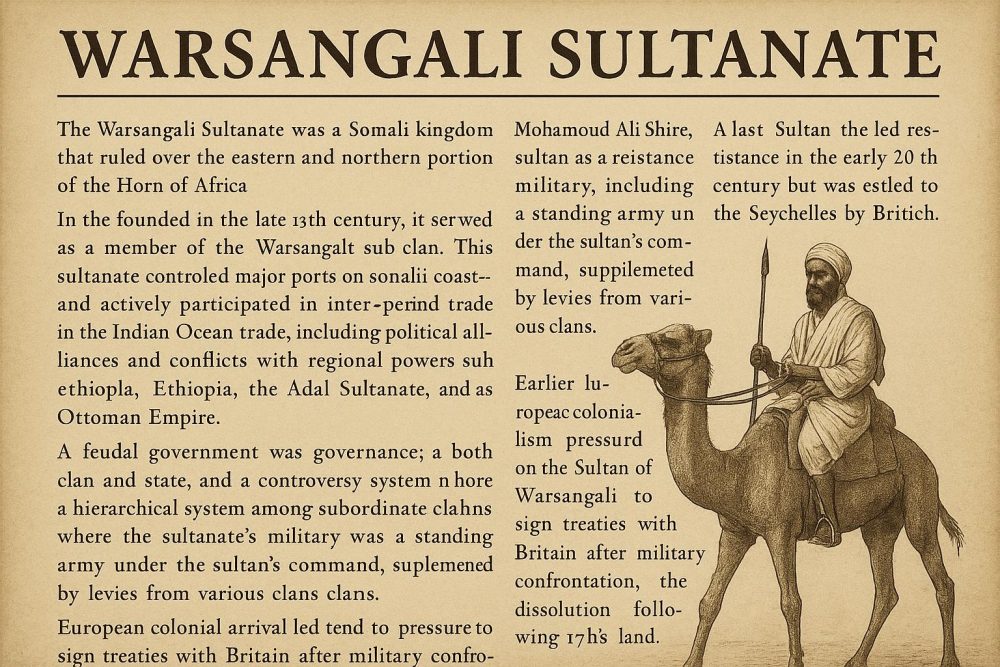
Introduction to the Warsangali Sultanate
The Warsangali Sultanate was an influential Somali sultanate that played a significant role in the historical landscape of the Horn of Africa. This Sultanate was established in what is now northeastern Somalia, specifically in the Sanaag and Bari regions. Its influence extended to encompass parts of the eastern and central regions of the country.
Founding and Expansion
The Warsangali Sultanate traces its roots back to the early 13th century. It was founded by Gerad Dhidhin, who was a prominent figure whose leadership laid the foundation for the Sultanate’s longevity and regional influence. Over time, the Warsangali expanded their territory through a combination of military prowess, strategic alliances, and trade.
Geopolitical Environment
The region during the time of the Warsangali was characterized by diverse cultures and competing interests. The Warsangali engaged in both conflict and cooperation with neighboring entities. Their strategic location afforded them access to trade routes that connected the interior of the Horn to the Arabian Peninsula and beyond. This access not only facilitated trade but also allowed the Warsangali to exert influence over regional politics and commerce.
Political Structure and Leadership
The political structure of the Warsangali Sultanate was hierarchical. The Sultan, also known as the Gerad, acted as the supreme authority, wielding significant influence over political matters. Below the Sultan, there were various chieftains who managed different regions within the Sultanate. This hierarchical structure helped maintain order and manage resources effectively within the sultanate’s territories. The leadership was often engaged in ensuring stability, resolving conflicts, and forging alliances, which were crucial for maintaining the integrity of the Sultanate.
Economic Activities
The economy of the Warsangali Sultanate was a blend of pastoralism, trade, and agriculture. The sultanate benefitted greatly from its involvement in trade, acting as an intermediary in the exchange of goods between Africa, the Middle East, and Asia. Notably, their trade in frankincense, a valuable commodity in international markets at the time, bolstered their economic status. The trade was facilitated by the region’s proximity to the coast, which allowed for the exchange of goods via maritime routes. Additionally, the local population engaged in pastoralism and agriculture, which supplemented the region’s economic base.
Cultural and Social Contributions
The Warsangali Sultanate was a melting pot of different cultures and traditions. The society was characterized by a rich oral tradition, with poetry playing a central role in everyday life. This tradition was often used to convey history, social values, and cultural narratives. Furthermore, Islamic scholarship was highly regarded, and the Sultanate became a center for religious learning and teaching. Prominent scholars from the Sultanate contributed to the spread of Islamic teachings and jurisprudence within the region.
Challenges and Decline
Despite its strengths, the Warsangali Sultanate faced numerous challenges. Internal conflicts, resource constraints, and external pressures from colonial powers in the 19th and early 20th centuries strained the Sultanate. With the advent of European colonialism, the region saw increasing interference, resulting in eventual decline. The pressures from European interests often led to conflicts over territory and resources, further exacerbating internal divisions and weakening the Sultanate’s cohesion.
Legacy of the Warsangali Sultanate
The legacy of the Warsangali Sultanate remains significant in Somali history. Its influence on the culture, politics, and economy of the region continues to be recognized by historians. The Sultanate’s contributions to the spread of Islam and the development of trade networks in East Africa have left lasting marks. The frameworks established by the Warsangali in terms of governance, trade, and cultural practices continue to resonate within Somali society. Moreover, the narratives and stories from this era are still celebrated and acknowledged as part of a larger Somali historical consciousness.
To learn more about the intricate history of the Horn of Africa, you may want to explore other scholarly articles and books from reputable sources available online. This will provide deeper insights into the role of the Warsangali Sultanate and its interactions with neighboring entities throughout its existence. By engaging with these resources, one can appreciate the complexity and richness of the region’s history, including the longstanding impact of the Warsangali Sultanate.